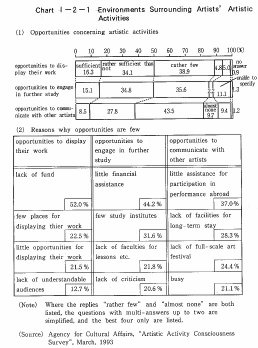| Home > Policy > White Paper, Notice, Announcement > White Paper > JAPANESE GOVERNMENT POLICIES IN EDUCATION, SCIENCE AND CULTURE 1993 > CHAPTER 2 �1 1 | ||
A major characteristic of' Japanese culture is that it is actually made up of two strains of cultural tradition that have blended together and coexist ; that of the traditional culture which has ripened and matured throughout Japan's long history, and that of Western culture which began to exert a strong influence when imported during Japan's modernization in the Meiji Period (1868-1912). A wide variety of art forms quickly blossomed under these two influences, including literature, art, music, dance and drama.
When responding to the "Artistic Activity Consciousness Survey", over half of the artists responding reported that they devoted over 200 days a year to artistic activities. The percentage, however, of those who are able to earn a livelihood through these activities, such as public performances and studio work is only 29%. It is apparent that many artists suffer under a financial strain, as can be seen from the figures for their annual income, with25% earning less than one million yen, 14% earning between 2 and 4 million yen and over 50% earning less than 4 million yen. Artists also expressed a low degree of satisfaction with the conditions in their artistic environments. Although 10 % of the artists polled reported that their environments were "satisfactory". More than half expressed some sort of dissatisfaction, with about 30 % reporting "less than satisfactory" environments and about 20% reporting "unsatisfactory" environments (Chart I- 1 - 9).
The most frequent points of discontent were, in order of frequency, "scarcity of financial assistance for art and culture", "lack of opportunities for public display of work", "lack of opportunities for further study" and "lack of opportunities to communicate with other artists".
When asked in more detail about opportunities to display their work, to engage in further study and to communicate with other artists, the resulting answers indicated that many artists were desirous of financial support in these areas (Chart I 2-1).

Although there has been an increase in the artist population and in the number of artistic performances (Chanter I-l-3. 4), the artistic environment (especially the economic environment) surrounding individual sand groups engaged in artistic activities cannot yet be considered completely satisfactory. There remains a need for the promotion of policies that actively assist and encourage creative artistic activities in such forms as the enrichment of subsidies from public funds. as well as the introduction of private contributions, providing opportunities for the nurturing and in-service training of artists, and the recognition of artistic achievement.
| Back to Top | MEXT HOME |